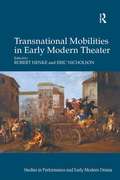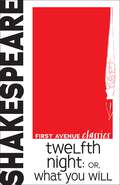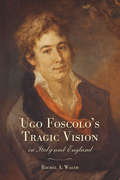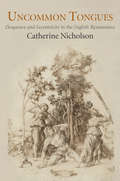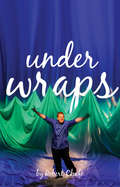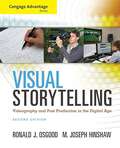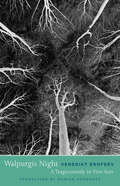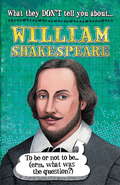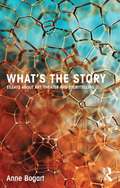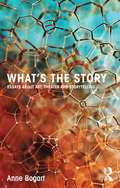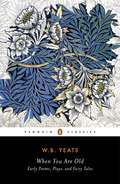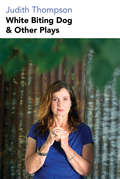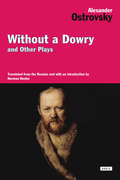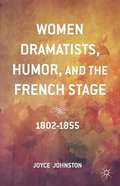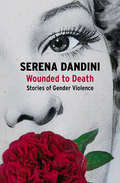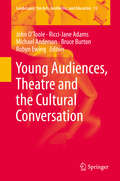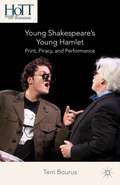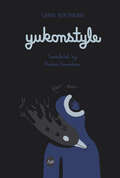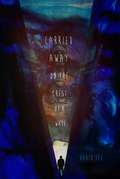- Table View
- List View
Transnational Mobilities in Early Modern Theater (Studies in Performance and Early Modern Drama)
by Robert Henke Eric NicholsonThe essays in this volume investigate English, Italian, Spanish, German, Czech, and Bengali early modern theater, placing Shakespeare and his contemporaries in the theatrical contexts of western and central Europe, as well as the Indian sub-continent. Contributors explore the mobility of theatrical units, genres, performance practices, visual images, and dramatic texts across geo-linguistic borders in early modern Europe. Combining 'distant' and 'close' reading, a systemic and structural approach identifies common theatrical units, or 'theatergrams' as departure points for specifying the particular translations of theatrical cultures across national boundaries. The essays engage both 'dramatic' approaches (e.g., genre, plot, action, and the dramatic text) and 'theatrical' perspectives (e.g., costume, the body and gender of the actor). Following recent work in 'mobility studies,' mobility is examined from both material and symbolic angles, revealing both ample transnational movement and periodic resistance to border-crossing. Four final essays attend to the practical and theoretical dimensions of theatrical translation and adaptation, and contribute to the book’s overall inquiry into the ways in which values, properties, and identities are lost, transformed, or gained in movement across geo-linguistic borders.
Twelfth Night: or, What You Will (First Avenue Classics ™)
by William ShakespeareIn the kingdom of Illyria, a love triangle has everyone on edge. Orsino loves Olivia, a bereaved noblewoman who is in mourning for her dead brother. Olivia loves Cesario, who is actually a woman named Viola. Viola had dressed as a man in order to gain employment in Orsino's household. Viola, of course, falls in love with Orsino, and he has no knowledge of the true identity of his "male" servant, Cesario. A romantic romp full of tricks, twists, and happy reunions, this unabridged version of William Shakespeare's classic comedy was first published in England in 1623.
Ugo Foscolo's Tragic Vision in Italy and England
by Rachel A. WalshOne of the most celebrated Italian writers of the early Romantic period, Ugo Foscolo (1778-1827) was known primarily as a novelist, a poet, and a nationalist. Following the Napoleonic Wars, he lived in self-exile in England during the last decade of his life. There he wrote numerous critical essays and collaborated with Lord Byron and other well-known members of English literary circles.Ugo Foscolo's Tragic Vision in Italy and England examines an underexplored aspect of Foscolo's literary career: his tragic plays and critical essays on that genre. Rachel A. Walsh argues that for Foscolo tragedy was more than another genre in which to exercise his literary ambitions. It was the medium for an elaborate life-long process of self-examination and engagement with political and literary conflict. By analysing Foscolo's tragic struggles on and off the stage, Walsh sheds new light on his career and how it reflects on the important literary and political trends of the time.
Uncommon Tongues: Eloquence and Eccentricity in the English Renaissance
by Catherine NicholsonIn the late sixteenth century, as England began to assert its integrity as a nation and English its merit as a literate tongue, vernacular writing took a turn for the eccentric. Authors such as John Lyly, Edmund Spenser, and Christopher Marlowe loudly announced their ambitions for the mother tongue--but the extremity of their stylistic innovations yielded texts that seemed hardly English at all. Critics likened Lyly's hyperembellished prose to a bejeweled "Indian," complained that Spenser had "writ no language," and mocked Marlowe's blank verse as a "Turkish" concoction of "big-sounding sentences" and "termes Italianate. " In its most sophisticated literary guises, the much-vaunted common tongue suddenly appeared quite foreign. In Uncommon Tongues, Catherine Nicholson locates strangeness at the paradoxical heart of sixteenth-century vernacular culture. Torn between two rival conceptions of eloquence, savvy writers and teachers labored to reconcile their country's need for a consistent, accessible mother tongue with the expectation that poetic language depart from everyday speech. That struggle, waged by pedagogical theorists and rhetoricians as well as authors we now recognize as some of the most accomplished and significant in English literary history, produced works that made the vernacular's oddities, constraints, and defects synonymous with its virtues. Such willful eccentricity, Nicholson argues, came to be seen as both the essence and antithesis of English eloquence.
Under Wraps
by Robert ChafeThe moment Mark meets David his world is thrown off balance. Who could have predicted finding love in a furniture store, or finding it with an unemployed lifeguard? But despite their immediate connection, Mark isn’t sure if David is gay. Mark isn’t even sure if Mark is gay. As he falls deeper in love, Mark works desperately to make David nothing more than a friend and to make that enough. Filled with hopeful exhilaration and devastating missed opportunities, Under Wraps nimbly tracks one man’s tumultuous quest to finally love himself and let it all out.
Visual Storytelling: Videography and Post Production in the Digital Age
by Ronald J. Osgood M. Joseph HinshawVISUAL STORYTELLING: VIDEOGRAPHY AND POST PRODUCTION IN THE DIGITAL AGE SECOND EDITION combines a thorough exploration of essential storytelling concepts with detailed instruction in practical technical skills. Without limiting its focus to a particular range of equipment, applications, or technology, this engaging text covers the key concepts, aesthetics, and techniques of single-camera field production and post production, and includes real-life stories and suggestions from working professionals.
Walpurgis Night, or the Steps of the Commander
by Marian Schwartz Venedikt ErofeevWalpurgis Night, by acclaimed Russian writer Venedikt Erofeev, is considered a classic in the playwright's homeland. Erofeev's dark and funny five-act satire of Soviet repression has been called the comic high-water mark of the Brezhnev era. Walpurgis Night dramatizes the outrageous trials of Lev Isakovich Gurevich, an alcoholic half-Jewish dissident poet confined by the state to a hospital for the insane. In "Ward 3"--a microcosm of repressive Soviet society--Gurevich deploys his brilliant wit and ingenuity to bedevil his jailers, defend his fellow inmates, protest his incarceration, and generally create mayhem, which ultimately leads to a tragedy of Shakespearean proportions.
What They Don't Tell You About: William Shakespeare
by Anita GaneriDid you know that Shakespeare couldn't spell his own surname? Love him or hate him, everyone has heard of the world's most famous playwright. But did the Elizabethans think he was a genius or simply that he wrote great soap operas? Any book on Shakespeare will give you the boring facts THEY think you should know, but only this one will tell you what the bard and his mates were REALLY like ... Uncover a wealth of information about Shakespeare! Find out where he was born and look at his family tree, see a map of Shakespeare's Stratford and Shakespeare's London, find out what school was like in Shakespeare's time, what London life was like and what sort of people went to the theatre. See a cross-section illustration of the Globe and discover how special effects were created and what actors wore. Read biographies of famous actors of the era such as Edward Alleyn, Richard Burbage, Richard Tarlton and William Kempe as well as biographies of contemporary writers Ben Jonson, Thomas Kyd and Christopher Marlowe. Read famous quotes and sayings and whizz your eye over a timeline of Shakespeare's plays and of his life. This book will tell you what Shakespeare's longest or shortest play is, or even which is the most miserable or goriest? It includes plots and information about ten of Shakespeare's plays: Richard III; Romeo and Juliet; A Midsummer Night's Dream; The Merchant of Venice; Henry V; Twelfth Night; Hamlet; Othello; Macbeth and The Tempest. It highlights some of Shakespeare's funniest characters and some of those that were in love. It concludes looking at how Shakespeare died, and discusses whether Shakespeare was, in fact, Sir Francis Bacon, Edward De Vere, Roger Manners, William Stanley or Christopher Marlowe. Finally, test your knowledge of all you've read with a fun 20-question quiz.
What's The Story: Essays About Art, Theater And Storytelling
by Anne BogartAnne Bogart is an award-winning theatre maker, and a best-selling writer of books about theatre, art, and cultural politics. In this her latest collection of essays she explores the story-telling impulse, and asks how she, as a ‘product of postmodernism’, can reconnect to the primal act of making meaning and telling stories. She also asks how theatre practitioners can think of themselves not as stagers of plays but ‘orchestrators of social interactions’ and participants in an on-going dialogue about the future.
What's the Story: Essays about art, theater and storytelling
by Anne BogartAnne Bogart is an award-winning theatre maker, and a best-selling writer of books about theatre, art, and cultural politics. In this her latest collection of essays she explores the story-telling impulse, and asks how she, as a ‘product of postmodernism’, can reconnect to the primal act of making meaning and telling stories. She also asks how theatre practitioners can think of themselves not as stagers of plays but ‘orchestrators of social interactions’ and participants in an on-going dialogue about the future. We dream. And then occasionally we attempt to share our dreams with others. In recounting our dreams we try to construct a narrative... We also make stories out of our daytime existence. The human brain is a narrative creating machine that takes whatever happens and imposes chronology, meaning, cause and effect... We choose. We can choose to relate to our circumstances with bitterness or with openness. The stories that we tell determine nothing less than personal destiny. (From the introduction) This compelling new book is characteristically made up of chapters with one-word titles: Spaciousness, Narrative, Heat, Limits, Error, Politics, Arrest, Empathy, Opposition, Collaboration and Sustenance. In addition to dipping into neuroscience, performance theory and sociology, Bogart also recounts vivid stories from her own life. But as neuroscience indicates, the event of remembering what happened is in fact the creation of something new.
When You Are Old: Early Poems, Plays, and Fairy Tales
by William Butler Yeats Rob DoggettRecalling Yeats's 1890s fascination in aestheticism and the arts and crafts movement, selections will draw from the first published versions of poems from works such as Crossways, The Rose, The Wind Among the Reeds, In the Seven Woods, The Green Helmet and Other Poems, Responsibilities, The Wild Swans at Coole, and Michael Robartes and the Dancer. A selection Irish myths and fairytales including "The Wanderings of Oisin," a Celtic fable and his first major poem, represent his fascination with mysticism, spiritualism and the rich and imaginative heritage of his native land.
White Biting Dog and Other Plays
by Judith ThompsonThis book collects some of Judith Thompson’s earlier, hard-to-find plays, including White Biting Dog, a poetic black comedy about a divorced lawyer who prepares to kill himself by jumping off the Bloor Street Viaduct—until he encounters a small dog who sets him on a different path; I Am Yours, a harrowing story about a group of characters on the brink of despair as each tries to escape what haunts them the most; and Pink, a moving monologue set in 1970s South Africa that centres on a young girl’s surprising reaction after her nanny is murdered during a protest.
Why Theatre Matters
by Kathleen GallagherWhat makes young people care about themselves, others, their communities, and their futures? In Why Theatre Matters, Kathleen Gallagher uses the drama classroom as a window into the daily challenges of marginalized youth in Toronto, Boston, Taipei, and Lucknow. An ethnographic study which mixes quantitative and qualitative methodology in an international multi-site project, Why Theatre Matters ties together the issues of urban and arts education through the lens of student engagement. Gallagher's research presents a framework for understanding student involvement at school in the context of students' families and communities, as well as changing social, political, and economic realities around the world.Taking the reader into the classroom through the voices of the students themselves, Gallagher illustrates how creative expression through theatre can act as a rehearsal space for real, material struggles and for democratic participation. Why Theatre Matters is an invigorating challenge to the myths that surround urban youth and an impressive study of theatre's transformative potential.
William Shakespeare (What They Don't Tell You About #29)
by Anita GaneriDid you know that Shakespeare couldn't spell his own surname?Love him or hate him, everyone has heard of the world's most famous playwright. But did the Elizabethans think he was a genius or simply that he wrote great soap operas? Any book on Shakespeare will give you the boring facts THEY think you should know, but only this one will tell you what the bard and his mates were REALLY like ...Uncover a wealth of information about Shakespeare! Find out where he was born and look at his family tree, see a map of Shakespeare's Stratford and Shakespeare's London, find out what school was like in Shakespeare's time, what London life was like and what sort of people went to the theatre. See a cross-section illustration of the Globe and discover how special effects were created and what actors wore. Read biographies of famous actors of the era such as Edward Alleyn, Richard Burbage, Richard Tarlton and William Kempe as well as biographies of contemporary writers Ben Jonson, Thomas Kyd and Christopher Marlowe. Read famous quotes and sayings and whizz your eye over a timeline of Shakespeare's plays and of his life.This book will tell you what Shakespeare's longest or shortest play is, or even which is the most miserable or goriest? It includes plots and information about ten of Shakespeare's plays: Richard III; Romeo and Juliet; A Midsummer Night's Dream; The Merchant of Venice; Henry V; Twelfth Night; Hamlet; Othello; Macbeth and The Tempest. It highlights some of Shakespeare's funniest characters and some of those that were in love.It concludes looking at how Shakespeare died, and discusses whether Shakespeare was, in fact, Sir Francis Bacon, Edward De Vere, Roger Manners, William Stanley or Christopher Marlowe.Finally, test your knowledge of all you've read with a fun 20-question quiz.
Without a Dowry and Other Plays
by Alexander OstrovskyOne of the most important Russian playwrights of the nineteenth century, Alexander Ostrovsky (1823-1886) is credited with bringing realism to the Russian stage. Contemporary of Turgenev, Dostoevsky, and Tolstoy and precursor to Chekhov, he was a keen sociological observer, often exposing abuses of power, landing him in trouble with the censors again and again. He wrote 47 original plays and began the tradition of acting today associated with Stanislavsky. Ostrovsky’s plays were written with performance in mind and with a masterful use of colloquial language. To this day they are a much-performed part of the Russian repertory. This volume collects four of Ostrovsky’s key plays, each from a different decade-A Profitable Position, An Ardent Heart, Without a Dowry, and Talents and Admirers, and is rounded out by the translator’s introduction, an afterword for each play, an extensive bibliography, and complete list of Ostrovsky’s works. .
Women Dramatists, Humor, and the French Stage
by Joyce JohnstonFilling a critical void, this book examines French women dramatists of the nineteenth century who managed to have their works staged prior to the lifting of censorship laws in 1864. Sophie de Bawr (1773 1860), Sophie Gay (1776 1852), Virginie Ancelot (1792 1875), and Delphine Gay de Girardin (1804 1855) all staged successful plays at Paris's top venues (Theatre Francais and Odeon) or at other selective theatres (Ambigu-Comique, Vaudeville, Gymnase) during this period without the aid or protection of a male coauthor. Between 1802 and 1855, all four of these dramatists were heavily involved in the literary scene of their day and hosted their own salons, venues essential for any male author wishing to see his works published and accepted among the public. While not always directly engaged in the politics of the day in their theater, these dramatists were aware of and influenced by the public sphere. Though none staged what today's critics would refer to as overtly feminist drama, through their use of humor, Bawr, Gay, Ancelot, and Girardin all cast aspersion upon patriarchal dominance and reconstructed ideals of womanhood that rejected traditional submissive roles. "
Women and Shakespeare in the Eighteenth Century
by Fiona RitchieFiona Ritchie analyses the significant role played by women in the construction of Shakespeare's reputation which took place in the eighteenth century. The period's perception of Shakespeare as unlearned allowed many women to identify with him and in doing so they seized an opportunity to enter public life by writing about and performing his works. Actresses (such as Hannah Pritchard, Kitty Clive, Susannah Cibber, Dorothy Jordan and Sarah Siddons), female playgoers (including the Shakespeare Ladies Club) and women critics (like Charlotte Lennox, Elizabeth Montagu, Elizabeth Griffith and Elizabeth Inchbald), had a profound effect on Shakespeare's reception. Interdisciplinary in approach and employing a broad range of sources, this book's analysis of criticism, performance and audience response shows that in constructing Shakespeare's significance for themselves and for society, women were instrumental in the establishment of Shakespeare at the forefront of English literature, theatre, culture and society in the eighteenth century and beyond.
Wounded to Death
by Serena DandiniThe voices too many women have lost; the dreams too many men have destroyed In these monologues originally written for theatrical performance, women who were victims of murder regain their voices to tell their truths. One woman, her body unceremoniously dumped in a well by her husband, laments the police force's halfhearted investigation of her murder. Another, forced to toil ceaselessly for a meager few euros per month, grows weary of enduring daily beatings and attempted rape and hangs herself from a crystal chandelier. Inspired by true events, these monologues represent what the victims of femicide might say, had they not been robbed of their voices. First staged as a play in 2012 in Palermo, Italy, Wounded to Death has taken Italy and the world by storm. Alongside the powerfully imagined speeches in this edition, Serena Dandini presents the grim global statistics of violence against women. This essential book showcases the author's exceptional capacity for creating nuanced emotion, from comic to painful, from grotesque to dramatic. With a factual basis and cinematic flair, these works compel the reader to consider the violence that is taking place right now all over the world.
Young Audiences, Theatre and the Cultural Conversation
by Michael Anderson Robyn Ewing Bruce Burton John O'Toole Ricci-Jane AdamsThis volume offers rare insights into the connection between young audiences and the performing arts. Based on studies of adolescent and post-adolescent audiences, ages 14 to 25, the book examines to what extent they are part of our society's cultural conversation. It studies how these young people read and understand theatrical performance. It looks at what the educational components in their theatre literacy are, and what they make of the whole social event of theatre. It studies their views on the relationship between what they themselves decide and what others decide for them. The book uses qualitative and quantitative data collected in a six-year study carried out in the three largest Australian States, thirteen major performing arts companies, including the Sydney Opera House, three state theatre companies and three funding organisations. The book's perspectives are derived from world-wide literature and company practices and its significance and ramifications are international. The book is written to be engaging and accessible to theatre professionals and lay readers interested in theatre, as well as scholars and researchers. "This extraordinary book thoroughly explains why young people (ages 14-25+) do and do not attend theatre into adulthood by delineating how three inter-linked factors (literacy, confidence, and etiquette) influence their decisions. Given that theatre happens inside spectators' minds, the authors balance the theatre equation by focusing upon young spectators and thereby dispel numerous beliefs held by theatre artists and educators. Each clearly written chapter engages readers with astute insights and compelling examples of pertinent responses from young people, teachers, and theatre professionals. To stem the tide of decreasing theatre attendance, this highly useful book offers pragmatic strategies for artistic, educational, and marketing directors, as well as national theatre organizations and arts councils around the world. I have no doubt that its brilliantly conceived research, conducted across multiple contexts in Australia, will make a significant and original contribution to the profession of theatre on an international scale. " Jeanne Klein, University of Kansas, USA "Young Audiences, Theatre and the Cultural Conversation is a compelling and comprehensive study on attitudes and habits of youth theatre audiences by leading international scholars in the field. This benchmark study offers unique insights by and for theatre makers and administrators, theatre educators and researchers, schools, parents, teachers, students, audience members of all ages. A key strength within the book centers on the emphasis of the participant voices, particularly the voices of the youth. Youth voices, along with those of teachers and theatre artists, position the extensive field research front and center. " George Belliveau, The University of British Columbia, Canada
Young Shakespeare’s Young Hamlet
by Terri BourusOne of the most vexing textual, theatrical, and interpretive puzzles in Shakespeare studies is the existence of three different versions of Hamlet. In this groundbreaking work, Shakespeare scholar Terri Bourus argues that this puzzle can only be solved by drawing on multiple kinds of evidence and analysis, including history of the book, theatre history, biography, performance studies, and close readings of textual variants. Combining the history of print culture with practical theatrical experience and special attention to Hamlet's women, Bourus presents here a case study of the "dramatic intersections" between Shakespeare's literary and theatrical working practices. In the process, she reshapes our assumptions about the beginning of Shakespeare's career and his artistic evolution.
Yukonstyle
by Sarah Berthiaume Nadine DesrochersGarin was two years old when his mother disappeared from a run-down East Vancouver neighbourhood. And now that the Robert Pickton trials are gaining national attention, Garin wonders if his mother, a First Nations woman, could be one of the unidentified victims. His ailing father isn't forthcoming with answers, and Garin's suspicions are at an all-time high. In the midst of all this, his roommate Yuko has taken in Kate, a young pregnant hitchhiker who unintentionally wreaks havoc on their friendship. But when Garin's father is hospitalized, nothing else matters but finally determining the truth about his mother. In this deftly written play, the characters grapple with the harsh Yukon winter within a world of racism, addiction, and loneliness.
carried away on the crest of a wave
by David YeeFrom the shore of Ko Phi Phi in Thailand to a suburb in Utah to a mysterious Kafkaesque hole in the ground, carried away on the crest of a wave gives us brief glimpses into the lives of a sphinx-like escort, a grieving father, a conflicted priest, brothers of legend, a felonious housewife, an accountant of time, an orphaned boy, a radio shock jock and a man who finds things. Each are connected, primarily, by the cataclysmic 2004 Indian Ocean tsunami that claimed the lives of over a quarter million people. In a series of vignettes, carried away on the crest of a wave illustrates the ripple effect of one of the deadliest natural disasters in recorded history and ponders what happens when the events that bind us together are the same events that tear us apart.
Žižek and Media Studies
by Matthew Flisfeder Louis-Paul WillisFilm, media, and cultural theorists have long appealed to Lacanian theory in order to discern processes of subjectivization, representation, and ideological interpellation. Here, the contributors take up a Zizekian approach to studies of cinema and media, raising questions about power, ideology, sexual difference, and enjoyment.
Žižek and Performance (Performance Philosophy)
by Broderick Chow Alex MangoldThe first edited volume to examine philosopher Slavoj Žižek's influence on, and his relevance for, theatre and performance studies. Featuring a brand new essay from Žižek himself, this is an indispensable contribution to the emerging field of Performance Philosophy.
Дон Кихот [Don Kikhot]: A Dramatic Adaptation (Texts and Translations #29)
by Mikhail BulgakovWhen Soviet censors approved Mikhail Bulgakov's ??? ?????, a stage adaptation of Don Quixote, they were unaware that they were sanctioning a subtle but powerful criticism of Stalinist rule. The author, whose novel ?????? ? ????????? would eventually bring him world renown, achieved this sleight of hand through a deft interpretation of Cervantes's knight. Bulgakov's Don Quixote fits comfortably into the nineteenth-century Russian tradition of idealistic, troubled intellectuals, but Quixote's quest becomes an allegory of the artist under the strictures of Stalin's regime. Bulgakov did not live to see the play performed: it went into production in 1940, only months after his death.The volume's introduction provides background for Bulgakov's adaptation and compares Bulgakov with Cervantes and the twentieth-century Russian work with the seventeenth-century Spanish work.
